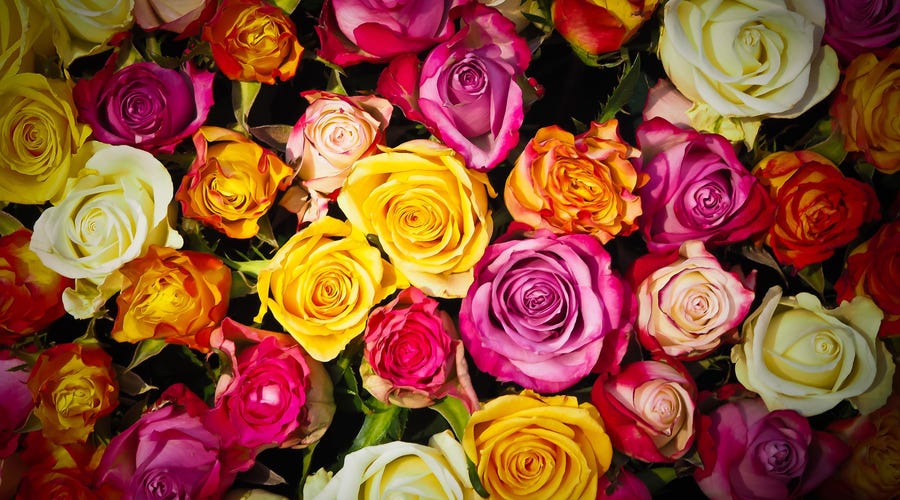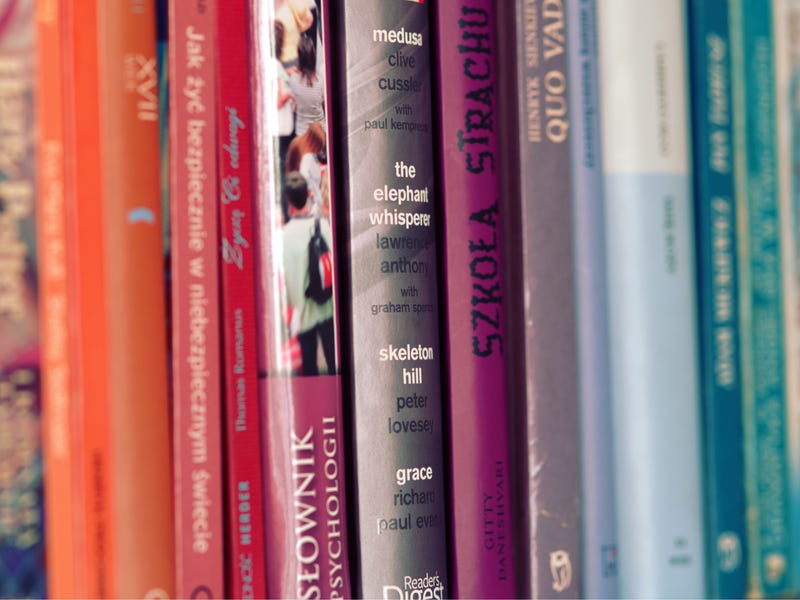
127 lovely flowers in German you'll grow quite frond of
Author: Marie Schmoll
You’ve been learning German for a while and your tongue is in a knot from long and spiky words like “Pünktlichkeit” (punctuality) and “Zahnarzt” (dentist)?
We get it, not all German words are exactly poetry material. That’s why you should learn these names of flowers in German. They include some of the prettiest German words.
Next time someone claims that German sounds harsh, you can finally argue against that by teaching them about German flowers - a beautiful topic to talk, write or even sing about.
So get ready for some soft, nice German words like “Flieder” (Lilacbush), “Mohn” (Poppy) and “Winterling” (aconite).
Download our FREE guide to flowering plants and their German names. Get planting!
Names of flowers in German
Flowers in German are “Blumen”, which is easy to remember, since they do bloom. That’s exactly how you pronounce them, too: one “Bloom-eh”, two “bloom-an”. Many German flower names are direct translations, for example, “sunflowers” in German are “Sonnenblumen”.
Some names are even almost identical to the English ones: “Crocus” is “Krokus”, “Hyacinth” is “Hyazinthe” and “Malva” is “Malve”. See? And you thought German was difficult.
We’re about to make this very easy from for you - with our detailed lists of German flower names from “Akazien” to “Zauberschnee”.
National flower of Germany, Austria, and Switzerland
Germany’s national flower is the cornflower. In the 1800s, Wilhelm I, emperor of Prussia, proclaimed the flower as his favorite and made it a symbol of the nation.
Its color, also known as Prussian blue, came to be the dominant color for the uniforms worn by the Prussian Army. Germany kept it as their national flower, while Austria and Switzerland both share the national flower of “Edelweiss”.

| Country | English | German (Singular) | IPA |
|---|---|---|---|
| Germany | Cornflower | Kornblume | [ˈkɔʁnˌbluːmə] |
| Austria | Edelweiss | Edelweiß | [ˈeːdl̩vaɪ̯s] |
| Switzerland | Edelweiss | Edelweiss | [ˈeːdl̩vaɪ̯s] |
Early bloomers in German
Let’s start with the first flowers of the year. Over the winter, Germany turns into a frosty place. The temperatures drop and snow covers the soil, so flowers don’t have a chance to bloom in the wild.
Then, in late February the first early bloomers take a peak and open their blossoms, often while the soil is still covered in snow. We can’t wait to spot these popular harbingers of spring. Picture dozens of little purple crocuses blooming on a snowy white meadow.

| English | German | IPA |
|---|---|---|
| Crocus | Krokus | [ˈkʁoːkʊs] |
| Cyclamen | Alpenveilchen | [ˈalpn̩ˌfaɪ̯lçən] |
| Daisy | Gänseblümchen | [ˈɡɛnzəˌblyːmçən] |
| Dandelion | Löwenzahn | [ˈløːvn̩ˌt͡saːn] |
| Hyacinth | Hyazinthe | [hyaˈt͡sɪntə] |
| Liverleaf | Leberblümchen | [ˈleːbɐˌblyːmçən] |
| Narcissus | Narzisse | [naʁˈt͡sɪsə] |
| Pansy | Stiefmütterchen | [ˈʃtiːfˌmʏtɐçən] |
| Poppy | Mohn | [moːn] |
| Primrose | Schlüsselblume; Primel | [ˈʃlʏsl̩ˈbluːmə; ˈpʁiːml̩] |
| Ranunculus | Ranunkel | [ʁa:nʊŋkəl] |
| Snowdrop | Schneeglöckchen | [ˈʃneːɡlœkçən] |
| Spring snowflake | Märzenbecher | [ˈmɛʁt͡sn̩ˌbɛçɐ] |
| Tulip | Tulpe | [ˈtʊlpə] |
| Violet | Veilchen | [ˈfaɪ̯lçən] |
| Wild daffodil | Osterglocke | [ˈoːstɐˌɡlɔkə] |
| Winter aconite | Winterling | [ˈvɪntɐlɪŋ] |
| Winter rose | Schneerose | [ˈʃneːˌʁoːzə] |
Download our FREE guide to flowering plants and their German names
Remember all the names of your favorite flowering plants in German with our printable poster. We've included planting tips on light, position, watering, and soil type.
Other wildflowers of Germany
As the weather gets warmer, Germans will get busy sowing seeds and gardening to get the backyards ready for summer.
At the same time, you’ll see more and more German wildflowers naturally pop up in the wild. Here are a number of wildflowers that are native to Germany.

| English | German | IPA |
|---|---|---|
| Adonis | Adonisröschen | [aˈdoːnɪsˌʁøːsçən] |
| Amber | Johanniskraut | [joˈhanɪskʁaʊ̯t] |
| Arnica | Arnika | [arˈɲika] |
| Bloomfell | Hornklee | [ˈhɔʁnˌkleː] |
| Bluebell | Glockenblume | [ˈɡlɔkn̩ˌbluːmə] |
| Burnet | Bibernelle | [biːbɐˈnɛlə] |
| Buttercup | Butterblume | [ˈbʊtɐˌbluːmə] |
| Chamomile | Kamille | [kaˈmɪlə] |
| Cleaver | Labkraut | [laːpkʁaʊ̯t] |
| Clover | Klee | [kleː] |
| Corydalis | Lerchensporn | [ˈlɛʁçn̩ˌʃpɔʁn] |
| Crowflower | Hahnenfuß | [ˈhaːnənˌfuːs] |
| Field poppy | Klatschmohn | [ˈklatʃmoːn] |
| Flax weed | Leinkraut | [ˈlaɪ̯nˌkʁaʊ̯t] |
| Forget-me-not | Vergissmeinnicht | [ˌfɛɐ̯ˈɡɪsmaɪ̯nnɪçt] |
| Foxglove | Fingerhut | [ˈfɪŋɐˌhuːt] |
| Hairy cat’s ear | Ferkelkraut | [ˈfɛʁkl̩kʁaʊ̯t] |
| Horsefoot | Huflattich | [ˈhuːflatɪç] |
| Knapweed | Flockenblume | [ˈflɔkn̩ˈbluːmə] |
| Liverwort | Leberblümchen | [ˈleːbɐˌblyːmçən] |
| Malva | Malve | [ˈmalvə] |
| Meadowfoam | Wiesenschaumkraut | [ˈviːzn̩ˌʃaʊ̯mkʁaʊ̯t] |
| Monkey flower | Gauklerblume | [ˈɡaʊ̯klɐˈbluːmə] |
| Pansy | Stiefmütterchen | [ˈʃtiːfˌmʏtɐçən] |
| Pigweed | Fette Henne | [ˈfɛtə ˈhɛnə] |
| Pippau | Pippau | [ˈpɪpaʊ̯] |
| Scabious | Witwenblume | [ˈvɪtvn̩ˈbluːmə] |
| Smallwort | Scharbockskraut | [ˈʃaːɐ̯bɔksˌkʁaʊ̯t] |
| Thimbleweed | Buschwindröschen | [ˈbʊʃvɪntˌʁøːsçən] |
| Thistle | Distel | [ˈdɪstl̩] |
| Viper's bugloss | Natternkopf | [ˈnatɐnkɔp͡f] |
| Woodruff | Waldmeister | [ˈvaltˌmaɪ̯stɐ] |
| Yarrow | Schafgarbe | [ˈʃaːfˌɡaʁbə] |
Tropical flowers in German
It’s always summer somewhere! Some of these plants might have a hard time blooming in Germany but others are popular plants you’ll find on German windowsills, probably looking out the window, dreaming of their tropical homes far, far away.

| English | German (Singular) | IPA |
|---|---|---|
| African Daisy | Kapkörbchen | [kapˈkœʁpçən] |
| Angel’s Trumpet | Engelstrompete | [ˈɛŋəlstʁɔmˈpeːtə] |
| Bird of Paradise | Strelitzie | [ʃtʁe:lɪ t͡si̯ə] |
| Bougainvillea | Bougainvillea | [buɡɛ̃ˈvɪlea] |
| Bromeliad | Bromelie | [bʁo:mɛlie:] |
| Canna | Achira | [axɪʁa] |
| Chenille | Katzenschwänzchen | [ˈkat͡sn̩ˈʃvɛnt͡sçən] |
| Clvia | Klivie | [ˈkliːvie] |
| Frangipani | Wachsblume | [vaksˈbluːmə] |
| Gardenia | Gardenie | [gɑːˈdiːniːə;] |
| Heliconia | Helikonie | [he:li:ko:ni:e:] |
| Hibiscus | Hibiskus | [hiˈbɪskʊs] |
| Lobster Claw | Hummerschere | [ˈhʊmɐˈʃeːʁə] |
| Lotus | Lotus | [ˈloːtʊs] |
| Medinille | Medinilla | [me:di:ni:la:] |
| Orchid | Orchidee | [ˌɔʁçiˈdeːə] |
| Passionflower | Passionsblume | [paˈsi̯oːnsˌbluːmə] |
Ornamental flowers in German
Asters and dahlias are typical fall flowers in Germany. They’ll still bloom in October and November, sweetening the last days of the season.
Many flowers are also potted and taken inside before the first frost, where they can last the whole year. These are some of the most popular ornamental flowers in Germany.

| English | German (Singular) | IPA |
|---|---|---|
| Acacia | Akazie | [aˈkaːt͡si̯ə] |
| Agapanthus | Schmucklilie | [ʃmʊkˈlɪlɪjɛ] |
| Anemone | Windröschen | [ˈvɪntˌʁøːsçən] |
| Aster | Aster | [ˈastɐ] |
| Aubrieta | Blaukissen | [ˈblaʊ̯ˌkɪsn̩] |
| Azalea | Azalee | [at͡saˈleːə] |
| Balloon Flower | Ballonglocke | [ba.lɔ̃[ˈɡlɔkə]] |
| Begonia | Begonie | [beˈɡoːni̯ə] |
| Bleeding heart | Tränendes Herz | [ˈtʁɛːnəndəs hɛʁt͡s] |
| Busy lizzie | Fleißiges Lieschen | [ˈflaɪ̯sɪɡəs ˈli:sçən] |
| Carnation | Nelke | [ˈnɛlkə] |
| Chickweed | Zauberschnee | [ˈt͡saʊ̯bɐʃneː] |
| Chrysanthemum | Chrysantheme | [kʁyzanˈteːmə] |
| Columbine | Akelei | [akəˈlaɪ̯] |
| Coneflower | Sonnenhut | [ˈzɔnənˌhuːt] |
| Dahlia | Dahlie | [ˈdaːli̯ə] |
| Edelweiss | Edelweiß | [ˈeːdl̩vaɪ̯s] |
| Fan-flower | Fächerblume | [ˈfɛçɐˈbluːmə] |
| Fuchsie | Fuchsie | [ˈfʊxsɪjɛ] |
| Geranium | Geranie; Storchschnabel | [ɡeˈʁaːni̯ə; ʃtɔʁçˈʃnaːbl̩] |
| Japanese Wisteria | Blauregen | [ˈblaʊ̯ˌʁeːɡn̩] |
| Jasmine | Jasmin | [jasˈmiːn] |
| Larkspur | Rittersporn | [ˈʁɪtɐʃpɔʁn] |
| Lilacbush | Flieder | [ˈfliːdɐ] |
| Lily | Lilie | [ˈliːli̯ə] |
| Marguerite | Margerite | [maʁɡəˈʁiːtə] |
| Marigold | Ringelblume | [ˈʁɪŋl̩ˌbluːmə] |
| Mullein | Königskerze | [ˈkøːnɪçsˌkɛʁt͡sə] |
| Peony | Pfingstrose | [ˈp͡fɪŋstˌʁoːzə] |
| Petunia | Petunie | [peˈtuːni̯ə] |
| Rose | Rose | [ˈʁoːzə] |
| Snapdragon | Löwenmäulchen | [ˈløːvn̩ˌmɔɪ̯lçən] |
| Sunflower | Sonnenblume | [ˈzɔnənˌbluːmə] |
| Sweet alison | Duftsteinrich | [ˈdʊftʃtaɪ̯nʁɪç] |
| Sweet mace | Samtblume | [ˈzamtˌbluːmə] |
| Tickseed | Mädchenauge | [ˈmɛːtçənˌʔaʊ̯ɡə] |
| Vervain | Verbene | [vɛʁˈbeːnə] |
More handy floral words in German
We already taught you about all the tasty veggies in German and also sweetened your vocab with the most delicious German fruits.
Now let’s have an even closer look at flowers - the most beautiful ones among the plants. Here are all the floral words you need to know, from roots to petals.

| English | German | IPA |
|---|---|---|
| Flower | Blume | [ˈbluːmə] |
| Blossom | Blüte | [ˈblyːtə] |
| Petals | Blütenblätter | [ˈblyːtn̩ˌblɛtɐ] |
| To bloom | blühen | [ˈblyːən] |
| In full bloom | In voller Blüte | [ɪn ˈfɔlɐ ˈblyːtə] |
| Plant | Pflanze | [ˈp͡flant͡sə] |
| Plant-based | Pflanzlich | [ˈp͡flant͡slɪç] |
| Stem | Stängel | [ˈʃtɛŋl̩] |
| Roots | Wurzeln | [ˈvʊʁt͡sl̩n] |
| Soil | Erde | [ˈeːɐ̯də] |
| Leaves | Blätter | [ˈblɛtɐ] |
| Pollen | Blütenstaub | [ˈblyːtn̩ˌʃtaʊ̯p] |
| Bee | Biene | [ˈbiːnə] |
| To pollinate | bestäuben | [bəˈʃtɔɪ̯bn̩] |
| Seeds | Samen | [ˈzaːmən] |
| Bouquet | Blumenstrauß | [ˈbluːmənˌʃtʁaʊ̯s] |
| Florist | Florist | [floˈʁɪst] |
| Flower shop | Blumenladen | [ˈbluːmənˌlaːdn̩] |
| Wildflowers | Wildblumen | [ˈvɪltˌbluːmən] |
A bouquet of fun ideas to increase your German flower appreciation
Here are some ways to make learning German flower words more fun.
1. Find the best flower shops in Germany
Germany has beautiful florists, like “Morgentau Floristik” (Morning dew floristry) in Hamburg or “Blütenkorb” (Flower basket) in Munich. Their names will teach you some new German flower words.
2. Inspect German perfumes
Some of the fanciest perfumes are from Germany, not just the famous “Eau de Cologne”. Pick your flowery favorites and memorize their ingredients in German.
3. Learn about German wildflowers
Look up (or maybe even visit) one of Germany’s beautiful wildflower trails like the flower trail St. Jakob in the Austrian East Tyrol or the Heidschnuckenweg trail through hundreds of pink flowers in North Germany.
Write a German flower poem
Have you always wanted to write a poem in German?
Probably not, but that’s only because you never knew all these beautiful flowery German words!
Nature and garden themes are perfect for list poems - a great way to try out creative writing in a foreign language.
This way you don’t have to worry about grammar too much. Just start listing what you see: birds, colors or, our favorite choice, flowers.
German can be soft and uncomplicated, like this short German poem about flowery garden memories.
Unser Garten
Erinnerungen an unseren Garten
Liegen in der Luft wie Blütenstaub
Oktober, in der Hand den Sparten
Feine Erde, buntes Laub
Im Mai Begonien und Flieder
Lavendel, Sonne, Sommerlieder
Warme Winde, kühle Quellen
Körbe mit goldenen Mirabellen
Our Garden
Memories of our garden
Lie in the air like pollen
October, a shovel in my hands
Fine soil, colorful leaves on the ground
In May, begonias and lilies
Lavender, sunshine, summer songs
Warm winds, cool springs
Baskets filled with golden mirabelles
Try writing your own little flower poem, just for fun - or the satisfaction of someone texting you what you’ve been up to today and being able to reply “Wrote a poem in German. WBY?”
Next up, you can move on to writing some grand German love poems. Our guides on “How to say I love you in German” and “genuine ways to compliment someone in German” will help you!
A rose by any other name
Remember to stop and smell the roses on the way. For language learning that means, try to appreciate the beautiful words you’ll learn and have fun with them.
And if you can’t remember the correct name for these flowers in German or get them mixed up, don’t worry. You’ll still get to enjoy their beauty and flowery scents. Since we’re being poetic today, keep in mind what Shakespeare said: A rose by any other name would smell as sweet.
Keep your German vocab blossoming on our German blog.



